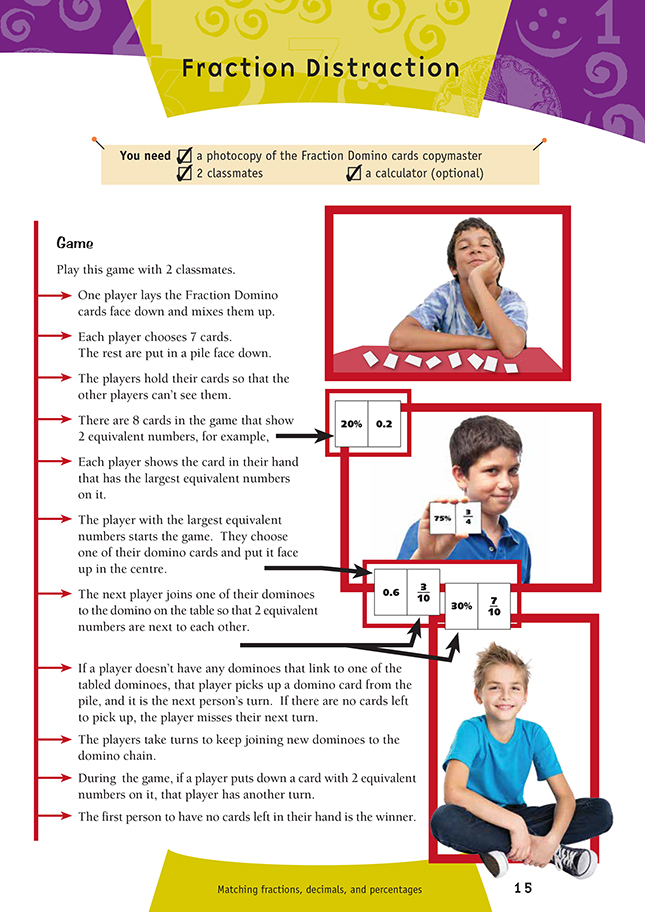This is a level 4 number activity from the Figure It Out series. It relates to Stage 7 of the Number Framework.
A PDF of the student activity is included.
Click on the image to enlarge it. Click again to close. Download PDF (596 KB)
match equivalent fractions, decimals, and percentages
Fraction Domino cards copymaster
FIO, Level 3-4, Number, Book 2, Fraction Distraction, page 15
2 classmates
A calculator (optional)
This game uses and develops the students’ knowledge of equivalency between fractions, decimals, and percentages. (See Number: Book Three, Figure It Out, Levels 3–4, page 24, which also deals with equivalent fractions, decimals, and percentages.)
You could introduce the cards (and model the vocabulary, for example, 2 tenths or 0 point 2) before the students start playing the game by dealing out all the domino cards to the class (or group). The domino cards show fraction, decimal fraction, and percentage equivalents for a half, quarters, thirds, fifths, eighths, and tenths.
Make a “multilevel” number line or table showing a range of the fractions, decimals, and percentages recorded on the dominoes. Group particular amounts together, such as halves, quarters, and eighths; fifths and tenths; then thirds separately to remind the students that thirds are recurring decimals or percentages (1/3 = 0.33333 …, 2/3 = 0.6666 …) and are shown by a dot over the reoccurring part of the number, for example, 0.3.
Multilevel number line for halves, quarters, and eighths:
Ask the students if they have a card that matches the missing fractions, decimals, or percentages on each number line. Record the equivalent numbers, making sure that everyone has a turn. Show them how to use the calculator to divide the numerator by the denominator to calculate the decimal and to multiply the decimal value by 100 to calculate the percentage. This is particularly useful for eighths, for example, 3 ÷ 8 = 0.375, 0.375 x 100 = 37.5 percent. (You could tell the students that percent means 1 part in every hundred and link this to the number of cents in a dollar. You
could also discuss with students that they can easily multiply by 100 mentally by moving the numbers 2 places to the left.)
Many students are able to instantly recall equivalent fractions, decimals, and percentages for particular amounts such as halves and quarters. This recall can be supported by using doubling and halving strategies to develop other equivalents. For example, “I know 1/4 is 25 percent, so 3/4 is 25 + 25 + 25 = 75 percent” or “I remember 1/8 is 0.125, so I just need to double it and double that again and add one more 0.125 to get 5/8 = 0.625.”
Reinforce the students’ knowledge of place value when dealing with the equivalency of 10 percent and its multiples (20, 30, 40 …). One-tenth = 1/10 or 0.1, which is 10/100 = 10 percent. Double this for two-tenths: 2/10 = 0.2, which is 20/100 = 20 percent, and so on.
Remind your students of the relationship between tenths and fifths to support conversion Double number lines based on percentages and money amounts are a good scaffolding tool for advanced multiplicative students and those in transition to advanced proportional. For example, in the double number line below, the students can find the value of 80% by subtracting the 20% amount from the 100% amount:
Another possible double number line involves finding 10% and then doubling:
After class or group discussion, redistribute the cards and play the game with the whole group, reinforcing the discussion points. Once the students have mastered the rules, send groups away to play the game independently. Keep playing the game yourself with those students who need more support.
Answers to Activity
Game
A game for matching fractions, decimals, and percentages


